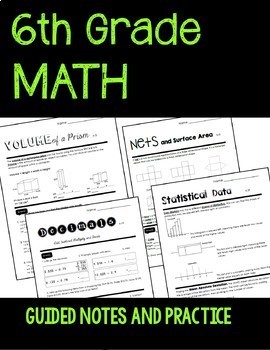6th Grade Math Guided Notes and Practice
- PDF
Description
6th Grade Math Guided Notes and Practice, featuring 29 lessons.
Easy to read lessons that emphasize the use of current mathematical practices and strategies.
Great for introducing the concept before your textbook lesson.
Organized by domain, with labels within each lesson to encourage the use of the Standards for Mathematical Practice.
Many possible uses: introductory lesson, weekly homework page, supplement your curriculum, math notebook, extra credit, interactive notebook resource, sub plans, end of the year review.
Each lesson is 2 pages, front/back printable, with math notes and differentiated practice.
Have students keep in their math binder to study throughout the year.
Includes student cover page and answer key.
*Your purchase is for 1 teacher license. This resource may be printed and distributed to your students in your classroom only. Please purchase additional licenses to share with other teachers. Thank you!
Ratios and
Proportional Relationships 6.RP
1. Ratios
2. Equivalent Ratios
3. Ratio Tables, Graphs, and Double Number Lines
4. Ratio Reasoning
5. Percents
6. Benchmark Percents
The Number System 6.NS
1. Dividing Fractions
2. Multi-Digit Division
3. Decimals
4. Greatest Common Factor (GCF)
5. Least Common Multiple (LCM)
6. The Number Line
7. Coordinate Plane
8. Absolute Value
Expressions and Equations 6.EE
1. Expressions
2. Writing Expressions
3. Order of Operations
4. Algebraic Expressions
5. Writing Equations
6. Solving Equations
7. Inequalities
Geometry 6.G
1. Area of a Triangle
2. Area of Polygons
3. Volume of a Prism
4. Nets and Surface Area
Statistics and Probability 6.SP
1. Statistical Questions
2. Measures of Center
3. Dot Plots, Histograms, and Box Plots
4. Statistical Data





